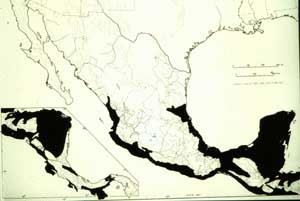|
|
 7 ant-acacia distribution DHJanzen100089.jpg high resolution
|
|
| The contemporary neotropical non-ant acacias (some 15+ species, 1-3 in any one site) occupy the black area in this map. This area is basically that of tropical dry forest and its intergrades into desert (along the Pacific coast of Mexico north of the Isthmus of Tehuantepec) and its intergrades into rainforest (e.g., southwestern Costa Rica, Panama Canal Zone). The interaction itself probably evolved in the intergrade between desert and tropical dry forest, with the nascent ant-acacia mutualism giving the acacia a competitive edge over other successional plants by both reducing herbivory and reducing shading by neighboring upright plants and vines (see later), thereby allowing it to move into more moist habitats than are generally occupied by the (classically) desert-occupying Acacia (see background of camel image earlier). In other words, an ant-acacia is a dryland plant that has evolutionarily moved into more mesic (moist) habitats by virtue of having a protective ant colony. In a few cases it has actually moved into rainforest. Below the bottom of this map, one species of ant-acacia (Acacia collinsii) occurred on the Pacific side of Colombia but it is nearly extinct there now. There may be a species of rainforest-occupying ant-acacia in the Choco of Panama (near the border with Colombia), but it has not been found (either Acacia allennii or Acacia melanoceras in Costa Rican/Panamanian rainforest are are candidates). Ant-acacias never (apparently) made it into the dry forest regions of South America, implying that either the South American dry forest (Venezuela, Bolivia, Brazil, Paraguay) has never been contiguous with Mesoamerican dry forest, or that the interaction evolved more recently than whatever was that connection if it was. | ||
back to lecture slides
or skip to: